M. Ali Lotfollahi Yaghin1, M. Reza Bagerzadeh Karimi2, Ali Rahmani3, V. Sadeghi Balkanlou2
1Prof. of Faculty of Civil Engineering, University of Tabriz, Iran
2Young Researchers and Elite Club, Islamic Azad University, Tabriz branch, Iran
3Department of Civil Engineering, Islamic Azad University, Maraghe Branch, Iran
Correspondence to: M. Reza Bagerzadeh Karimi, Young Researchers and Elite Club, Islamic Azad University, Tabriz branch, Iran.
| Email: |  |
Copyright © 2014 Scientific & Academic Publishing. All Rights Reserved.
Abstract
Structural engineers have long been trying to develop solutions using the full potential of its composing materials. At this point there is no doubt that the structural solution progress is directly related to an increase in materials science knowledge. These efforts in conjunction with up-to-date modern construction techniques have led to an extensive use of composite floors in large span structures. A direct consequence of this new design trend is a considerable increase in problems related to unwanted floor vibrations. For this reason, the structural floors systems become vulnerable to excessive vibrations produced by impacts such as human rhythmic activities. The main objective of this paper is to present an analysis methodology for the evaluation of the composite floors human comfort. This procedure takes into account a more realistic loading model developed to incorporate the dynamic effects induced by human walking. Based on an extensive parametric study the composite floors dynamic response was obtained and compared to the limiting values proposed by several authors and design standards. This strategy was adopted to provide a more realistic evaluation for this type of structure when subjected to vibration due to human walking
Keywords:
Vibration, Resonance, Composite floors, People’s rhythmic movement, Dynamic analysis, ABAQUS software
Cite this paper: M. Ali Lotfollahi Yaghin, M. Reza Bagerzadeh Karimi, Ali Rahmani, V. S. Balkanlou, Investigating the Behavior of Composite Floors (Steel Beams and Concrete Slabs) under Mans Rhythmical Movement, Journal of Civil Engineering Research, Vol. 4 No. 2, 2014, pp. 25-32. doi: 10.5923/j.jce.20140402.01.
1. Introduction
As it was stated, nowadays, composite floors have many applications and are used in building floors which has wide area such as a place of assembly, conference halls, stores and sports halls. Since these kinds of floors are considered thin structure, therefore, they are sensitive to the vibrations resulted from people’s movements and this leads to occurring of insecurity feeling among the users. Most of the previous studies were about people’s motions resulted from people’s exercising or walking but in current research, type of loading was different. Regarding the type of Iranian’s culture and customs, some of religious ceremonies are held in covered places and these are such as mosques and hoseiniyeh and mostly composite floors of steel beam and concrete slabs are used in these buildings. In this research, it is trying to study the dynamic behavior of structure influenced by the load resulted from people’s movement during mourning ceremonies on composite floors.Every structural system fluctuates when it is loaded by beat. The manner of replying this system to dynamically load depends on physical and loading specifications. Composite floors vibrate against dynamic loading like walking. This vibration is transferred to the occupants and maybe leads to undesired feeling in them. According to widespread researches which were done, it is possible to classify the feeling of occupants from floor’s vibration regarding the vibration’s specifications. First control criteria for dynamic vibration only were limited to slab frequency. According to these relations, slab frequency shall be more than 4 to 6 Hz to nullify the vibratory resonance in the floor. Since loading frequency during mourning is about 1.24 to 1.58 Hz, so deviating from this number nullifies the resonance probability. In continuation, we can refer to a graph which was provided by Lenzen, K.H (1). Lenzen’s studies were done following Reiher, H and Meister, F.J (2) works which leads to improving and correcting their studies. Fig (1) shows the feeling level of users from floor’s vibration based on free vibration frequency of floor and dynamic displacement. This graph has four parts:A: in part 1, vibration is not felt.B: in part 2, vibration feeling is very low and is only felt by very precise persons. C: in part 3, vibration is felt obviously. This state is the warning threshold in floor and if a floor is put in this range, insecure feeling is transferred to the occupants. D: in 4th state, vibration is extremely felt and exploitation is disturbed and structure’s efficiency is gradually beyond the profitability. According to this graph, if the frequency of slab’s free vibration is vertically available, having computed the slab’s dynamic displacement, we can reach to the users’ feeling level of vibration. According to Hicks, S studies (3) which were done on the results of AISC/CISC common committee, slab frequency is computed as one degree of freedom regarding system’s free vibration.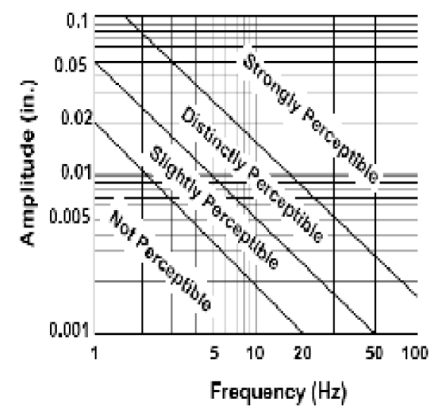 | Figure 1. Graph of the vibration feeling threshold (7) |
In the next phase, maximum acceleration in the slab is computed regarding simple relations and the slab’s security level is computed regarding the maximum acceleration and frequency. Murray, T.M (4) mentioned that considering vibration specifications of floor, if the minimum required damping computed for controlling vibration is more, floor’s vibration is not bothering and will be diminished quickly. This research aims at reaching total evaluation of slab’s composite behavior in loading resulted from people’s movements. In this regard, the limited parts model of the concrete composite slab was analyzed in ABAQUS ver. 6.9.2 under loading of people’s movement. Boundary conditions of the slab, dimensional specifications, peripheral beams and major beams specifications and beams interval in different models are changing and the results of each phase are studied, ultimately, we can reach on the dynamic response of composite floor, which is the most important of slab’s frequency and floor’s displacement in loading conditions and new geometry and also controlling the occurrence of resonance. The most important analysis result of dynamic model is studying the sensitivity of slab’s dynamic parameters (displacement and frequency) to boundary conditions of slab and its geometry and also the amplitude of structure’s resonance. In this research, it will be tried to model different types of composite floors and analyze the modeling. Meanwhile, different modes of this sample will be studied and structure’s natural frequency will be studied regarding the occurrence of resonance. Those models of composite floors were dynamically loaded by people’s rhythmic movements to study and analyze the dynamic response of the samples. In 1679, Borelli, and Weber brothers (5) has done studies about people’s movements. In 1895, some researchers such as German Otto Fischer have done the first studying including the examination of the complex forces of people’s movements. He was the pioneers of this area in studying. Elftman could define the ground’s reaction loaded by pedestrian movements (6). He constructed a 1-m dimension steel sheet which has four supports as short pillars and having done studies on this model, he could reach on the forces quantity and ground’s reaction. Rainer (7) was the other one who participated in these researches and masterly obtained the platform load resulted from the people’s feet reactions in motion. Ebrahimpour (8) developed his studies in this area and designed a 2-m wide and 14.2-m long platform and recorded people’s motion in different groups as one, two or four persons. Stimulus force, which applies through the heel during motion, produces a transient response that means a time in which the system is stimulated by instantaneous loads. Murray and Hendrick (9) measure the pressure of people’s movement by a seismograph put on 9 formality churches, 3 store slabs, 2 hotel balcony slabs and a 2-floor commercial building. According to these results, dynamical responses of structures such as maximum force, frequency and damping were studied.Alves and Faisca (10,11) have done tests on volunteers on concrete platform and these tests could develop the response of stimulus loads resulted from jumping, aerobics and etc. His tests were done on two platforms, one concrete and rigid and the other was flexible, both had movable supports. This kind of supports can change the stiffness of the structure.Although the studies related to floors vibration which is occurred by the individuals was significantly increased regarding the previous years, but we should consider that these researches are not new and modern. In 1828, the criteria were proposed which was related to least undesired effects depends on floor vibration by increasing the beam height of the structures with long span. Reiher and Meister measured the ability of understanding and feeling the vibration of the floor by the individuals.
2. Resonance
If the frequency of the applied load is equal to the natural frequency of the structure, the structure will be resonated and its vibration amplitude will be extreme in no damping, in the case of occurring of such big vibration amplitudes causes to create destructive tensions in the structure. When we hit any physical component, it starts to vibrate and then gradually diminishes. If we strike with the same frequency to that object, its vibrating amplitude will be increased and this is called resonance. Resonance is occurring in definite frequencies for any mechanical system which relate mostly to physical conditions and its supports.
3. Measuring Frequencies
Mourning custom is one of the ceremonies in Iranian customs which is a part of the people’s culture, regardless to the type of geographical region where these ceremonies are, they are held as grouping and with a special order. Mainly, it is held in a series in which the mourners hit their feet on the ground during regular motion and if such action is held in a building, it may lead to occurring of vibration movement in the building’s floor and studying the manner of floor’s dynamic response to incoming stimuli has special importance and rhythmic vibrations resulted from people’s movement lead to discomfort among users. The most secure method for measuring these frequencies is its practical measuring. In this research, three different mourning styles were considered and stimulus frequency (people’s footstep frequency) was measured. More than 20 times measuring was done for each of mourning styles. Having studied the obtained measurements, it becomes clear that stimulus frequency ranges from 1.42 ≤F≤ 1.58 Hz.
4. Research Model
The floor system which was considered is a 15-cm thickness concrete slab with steel beam. Major beams are IPE450 and peripheral beams are IPE300. Pillars are IPE450 Fig (2). The thickness of the concrete slab is variable which will be explained in different samples of this type at following. The sample structure plan is shown in figure 3. Figure 4 shows the finite element structural model.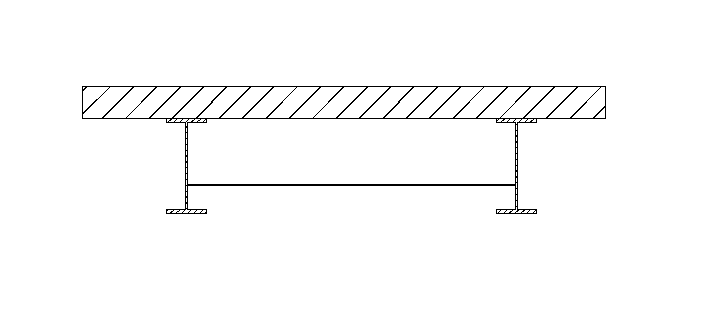 | Figure 2. Transect of composite floor |
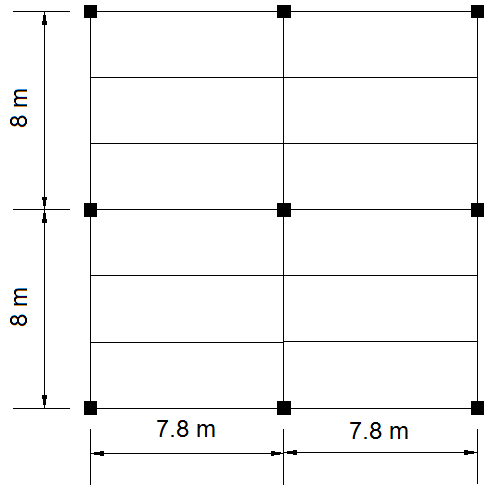 | Figure 3. Plan of sample structural model |
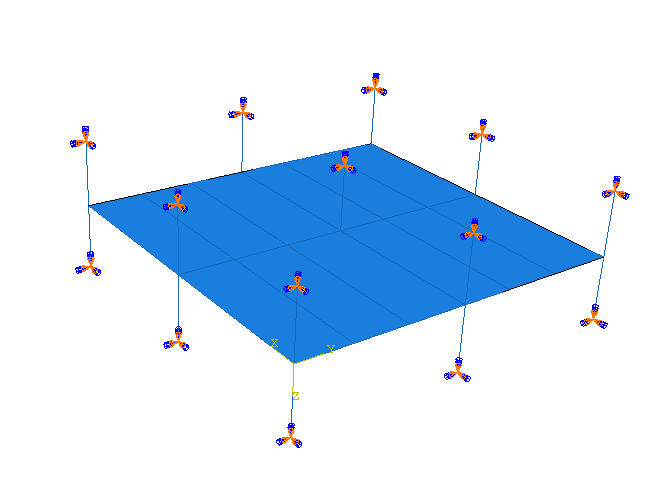 | Figure 4. Finite element model |
 where, Fy, Fu, E, v, F’c is yield strength, ultimate tensile strength, modulus of elasticity, Poisson's ratio and strength of concrete, respectively.The most important aim in this part of the research is composite slabs, finding the natural frequency of structure in different models. Steel columns and beams were modeled as shell in software and concrete slab as a shell. Frequency analyses were done on different structural samples and it was observed that in all samples, increasing the structural stiffness will increase the natural frequency of the structure. The frequency of a sample of composite floor with 9 columns was analysed and several of their samples are provided at the following, Figures (5, 6, 7, 8).
where, Fy, Fu, E, v, F’c is yield strength, ultimate tensile strength, modulus of elasticity, Poisson's ratio and strength of concrete, respectively.The most important aim in this part of the research is composite slabs, finding the natural frequency of structure in different models. Steel columns and beams were modeled as shell in software and concrete slab as a shell. Frequency analyses were done on different structural samples and it was observed that in all samples, increasing the structural stiffness will increase the natural frequency of the structure. The frequency of a sample of composite floor with 9 columns was analysed and several of their samples are provided at the following, Figures (5, 6, 7, 8).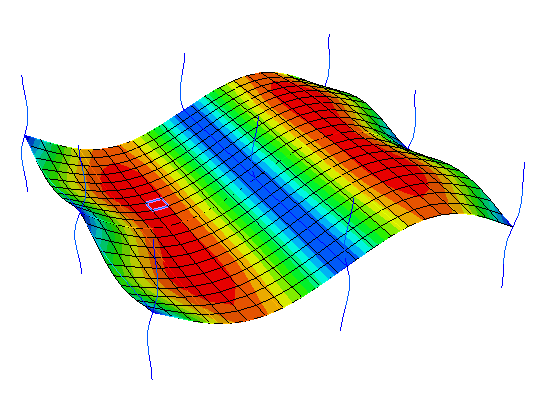 | Figure 5. Second mode of natural frequency (1.16Hz) |
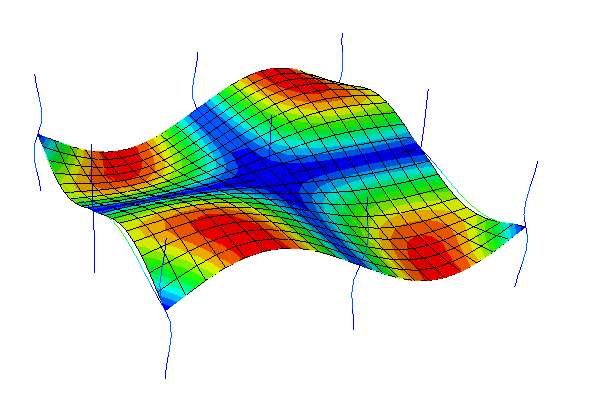 | Figure 6. Third mode of natural frequency (1.35 Hz) |
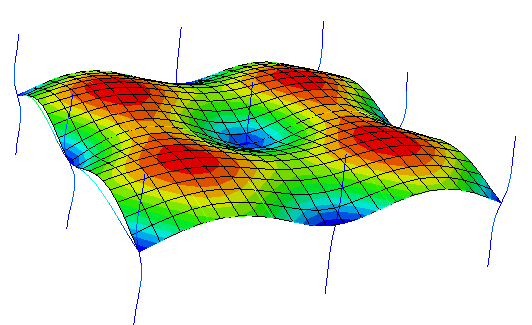 | Figure 7. Fifth mode of natural frequency (1.42 Hz) |
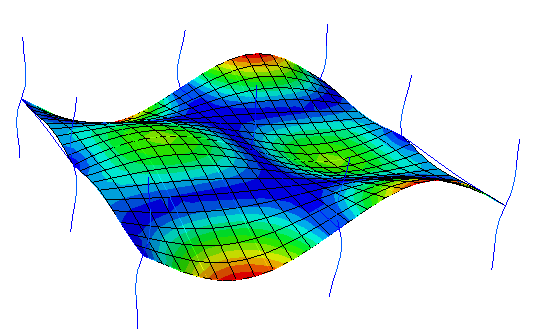 | Figure 8. Eighth mode of natural frequency (2.26 Hz) |
In table (1), the quantities of the natural frequency of the sample in different thicknesses are provided and it is observed that increasing the thickness will increase the natural frequency of the structures and in some modes, the natural frequency of the structure is close to the stimulus frequency. In addition, occurring of resonance phenomena will be studied at the following.| Table 1. Natural frequency of the slab in different thicknesses (Hz) |
| | Thickness | mode 5 | mode 8 | mode 9 | mode 10 | mode 15 | | 12 | 0.7 | 1.3 | 1.3 | 1.3 | 1.8 | | 15 | 0.8 | 1.4 | 1.5 | 1.6 | 2.1 | | 17 | 0.9 | 1.6 | 1.7 | 1.7 | 2.4 | | 20 | 1.0 | 1.8 | 1.8 | 1.8 | 2.7 | | 22 | 1.1 | 1.7 | 1.9 | 2.0 | 3.0 | | 25 | 1.2 | 1.9 | 2.1 | 2.2 | 3.3 | | 27 | 1.3 | 2.1 | 2.3 | 2.3 | 3.6 | | 30 | 1.4 | 2.3 | 2.5 | 2.5 | 4.0 |
|
|
Since the stimulus frequency in this research ranges between 1.24 and 1.58 (1.42≤F≤1.58), so more far from this quantity, the structure will have the proper security due to resonance. Increasing natural frequency and far from the resonance frequency range equals to increasing the structural stiffness and in increasing the stiffness of the structure, plasticity and economically of the structure shall be taken into account. The other point in studying of sample modes is that we should not be sufficed with 1st mode or several preliminary modes, since as it was seen, in most of the samples, in different modes, the natural frequency of the structure was closed to the resonant frequency range and this will not be desired. So the first control criteria for dynamic vibration is only limited to slab frequency and if we can increase the natural frequency of the slab to about 4 or 5 Hz, the probability of resonance will be nullified.B. Load Resulted from mans MovementsThe main propose of this research is studying the dynamic effects of several regular and group movements of people on thin structures. Our mean of thin structure is composite floors composed of steel beams and concrete slabs. The structure’s period is studied and investigated the dynamic effect and period of group movements are recognized and evaluated. Firstly, the period of several real samples of mourning ceremonies is recorded in which the people stand in the series and hit their feet on the floor rhythmically which was previously explained. The next phase is computing the input forces to the floor. There are different methods for computing the input loads by people’s movements. The researchers have previously done widespread studies about loads resulted from people’s movements on floors. Since the applied loads are imposed as a result of people’s instantaneous movement, so studying the floor’s response against applied loads has special importance. And also applied loads instantaneously caused studying on dynamic response of the structures to have particular difficulties. The most important result of these widespread studies by researches about floors response by people’s movements is creating a comfort feeling among the users. Fig (9) shows the type of loading of human’s movements on the floor. | Figure 9. Type of loading of human’s movements on the floor |
Maximum compressive and tensile stress of concrete defined as 223 kg/cm2 and 17 kg/cm2, respectively.C. LoadingAt this time, the amount of burden caused by individuals movement. In practical experiment is done with step interval about 50 cm and also step interval is taken into account in this sample and the amount of 60kg load is applied. Rows interval of mourning is taken about 2m. Overall, on a slab with the dimension of 15.7m x 16m, 8 rows are located where on each row 30 are stayed side by side. So called, there are 240 on this area and in mourning. Fig (10).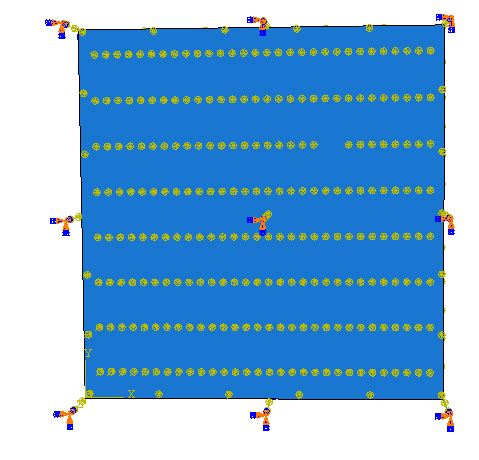 | Figure 10. Slab’s loading |
5. Output Results
In Fig (11), tension of concrete slab affected by loading was shown that the maximum of which is about 8.6 kg/cm2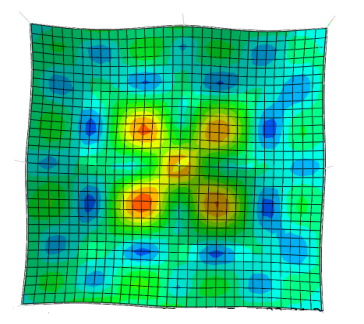 | Figure 11. Results of concrete slab tension |
Beams tensions are put in a desired range and in some of points, the maximum tension reaches on 1200 kg/cm2. Alternatively, the analysis results of sample (displacement) of the slab are studying and output shape of the composite floor displacement affected by loading are as figure 12.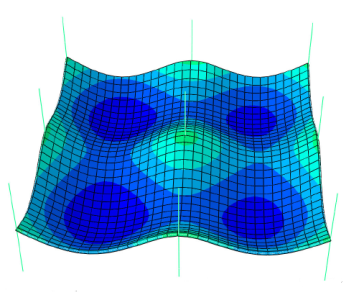 | Figure 12. Displacement output of composite floor |
The maximum displacement of samples is occurring in the middle of panels and it is 4 cm. in studying sample, the loading is applied as point in 240 points each 60 kg on slab. This quantity of load is imposed as widespread loading in total area of 15.6×16 square meters to study the comparison of the effects of the point load with the same quantity of load. 240 persons stand in 8 rows of 30 persons. The quantity of widespread equivalent load equal to the individuals loading in mourning is 0.00576 kg/cm2. In previous sample, we omitted the point load resulted from people’s movement and applied a widespread load of 0.00576 kg/cm2 on whole of slab’s area, the force was applied dynamically. The mentioned load was imposed to the composite floor during 0.63 seconds dynamically. The maximum concrete tension of slab affected by widespread loading analysis mode is about 1.3 kg/cm2. It can be clearly seen that equivalent of widespread loading is less than single load which is 8.6 kg/cm2. And also concrete’s tension for dynamic state is 2.5 kg/cm2. Furthermore, loadings were (0.00576 kg/cm2) tripled. The sample which was under 3-time equivalent loading is dynamically analysed in order to compare the tension of concrete slab in this state with the point load state. The tension curve of the concrete slab for one-time and three-time equivalent loading in dynamic analysis is shown in figure 13 and 14. It is obvious that even three-time equivalent loading is not reached to the tension of concrete slab in the point loading state. Tension of concrete slab in point loading state =8.6kg/cm2Tension of concrete slab in three-time equal load state = 3.95 kg/cm2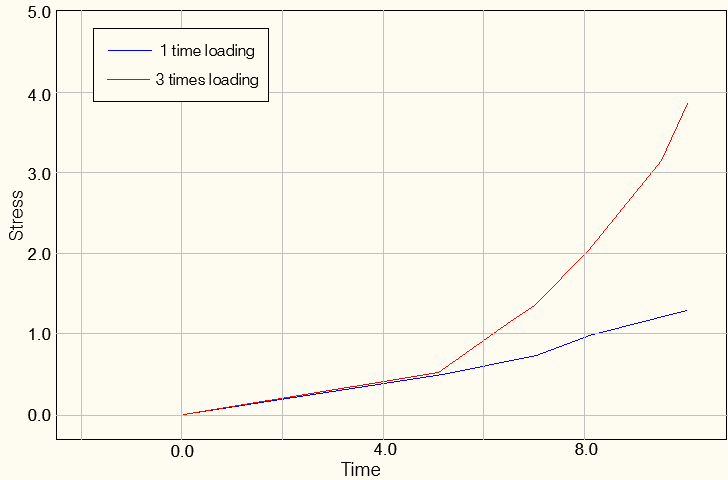 | Figure 13. Tension graph of concrete slab in 1-time and 3-time equivalent loading |
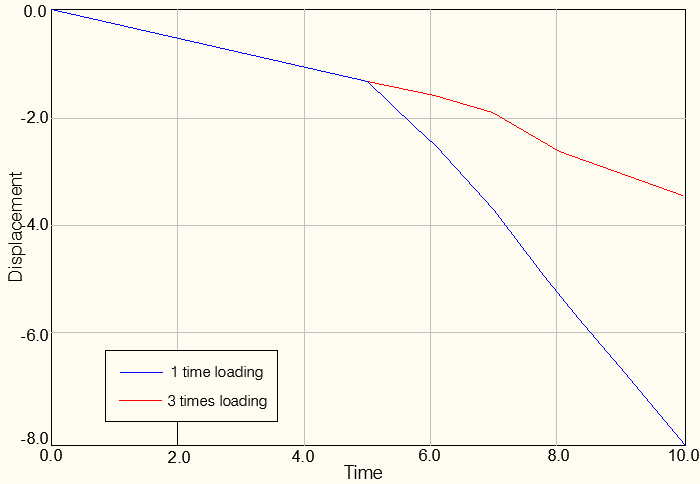 | Figure 14. Graph of slab displacement in 1-time and 3-time equivalent loading |
Figure 13 shows the displacement of concrete slab which is affected by 1-time and 3-time equivalent loading. Displacement of slab in point loading = 4 cmDisplacement of slab in 1-time equivalent loading = 3 cmDisplacement of slab in 3-time equivalent loading =8.5cmSince it does not reach on tension of concrete slab in the point loading state, so equivalent loading becomes 6 times more to study the results again. Now, once again, the new load of sample is dynamically analysed and the results are presented as follow: Fig (15)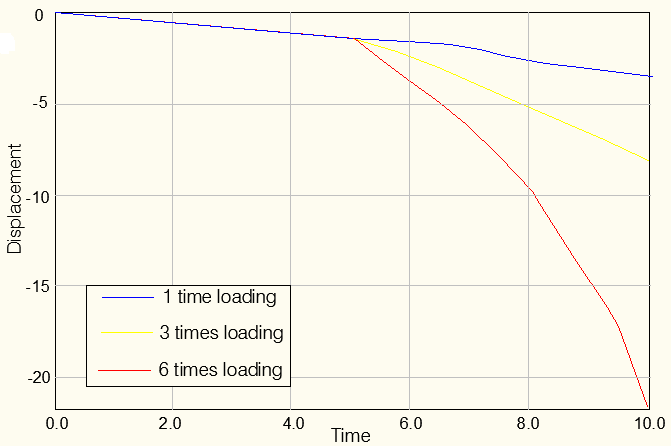 | Figure 15. Displacement curve of concrete slab, affected by 1, 3 and 6-time loading in dynamic analysis |
It can be observed that the displacement of slab under loading has six times increased as more as the point loading. Fig (16)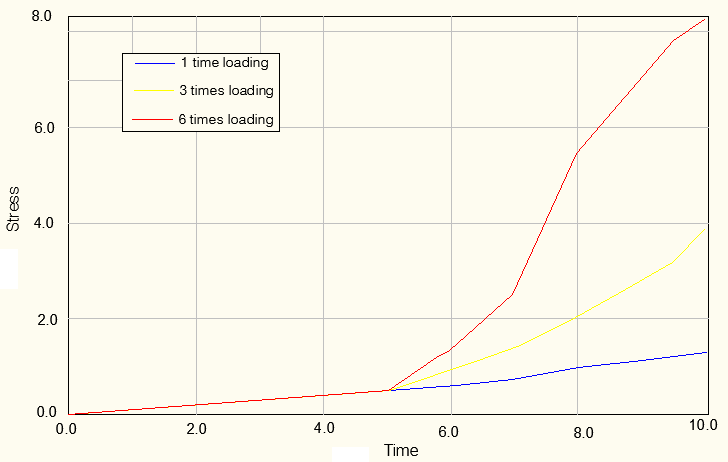 | Figure 16. Tension curve of concrete slab affected by 1, 3 and 6-time loading in dynamic analysis |
The attractive results of the previous graphs are that tension of concrete slab reaches to the point loading after it becomes six times more, so it is clear that although point equivalent loading resulted from people’s movement is less, it is six times more effectively on tension of concrete slab than widespread loading state. The importance of precise investigation of dynamic response of people’s movements on structure’s floors is defined at the following. In this case, controlling the natural frequency of structure for preventing from occurring resonance is one of the important factors in controlling structural slab and controlling the displacement and slab’s tension in loading resulted from people’s movements is the other factor.Moreover, the desired sample is loaded according to shape mode, for this regard, we select fifth shape mode and the point loads only applied in a region which has transformation mode. Then, it is dynamically analysed. The results are presented as follows: the 60-kg point loads are applied in points which have the greatest displacement. Fig (17) 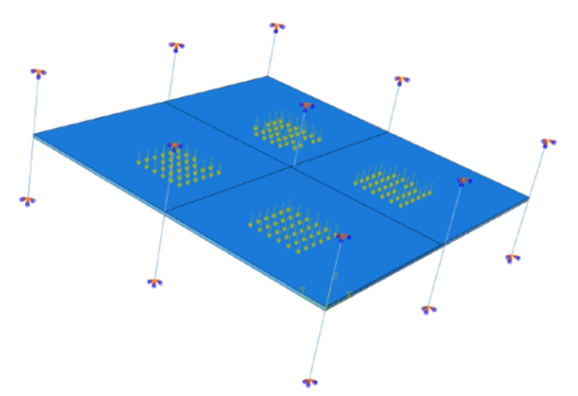 | Figure 17. Loading the finite element sample |
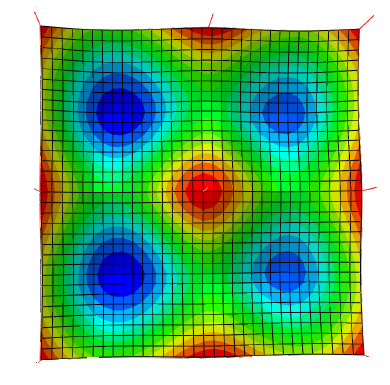 | Figure 18. Showing the slab’s displacement |
The maximum buckling (failure) is shown in figure 18 which is about 3.13 cm. As it is defined in the figure; the maximum buckling is occurring in the middle of the floor. Tension of the concrete slab is about 1.5kg/cm2. Fig (19)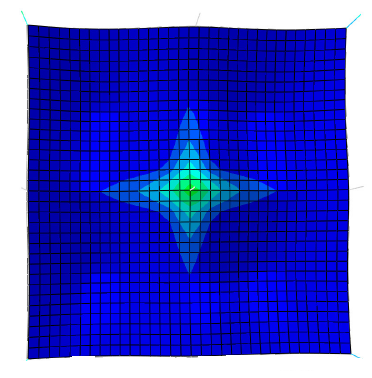 | Figure 19. Tension of concrete slab |
In table (2), the replies of different samples are compared due to type of loading. In desired mode shape, since the loading is only applied as forth, so it hardly reaches resonance and the load shall two-ply. In an earthquake or wind force, the load is applied as back and forth and if load’s frequency equals to structure’s frequency, resonance will be occurred, but since in this research, the live load is only entered as forth, so if mode shape is such that moves in two opposite directions and the load is applied in two periods which has 180 degree phase difference, the resonance will be occurred. In second shape mode, the live load in only applied as positive and it is not negative unless the shape mode is such that phase difference will be created to negate its effect in the next direction.Table 2. Types of loading states and obtained results
 |
| |
|
Second mode shape is loaded as symmetrical and in one row and the load is applied with the natural frequency of the desired mode to study about the resonance phenomena. Fig (21)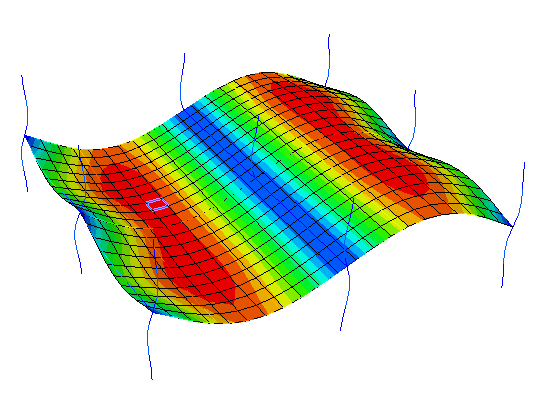 | Figure 20. Symmetry shape mode (second mode) |
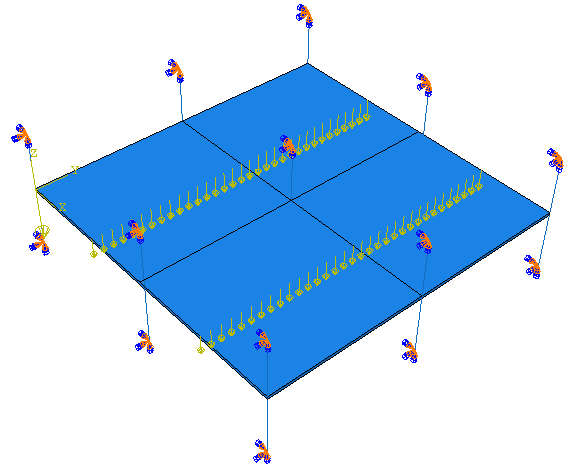 | Figure 21. Loading model of finite element |
It seems that dead loads of the structure shows a resistance against resonance occurring that means when the load is applied and the structure buckled, then the load is removed and returns to primary state, the dead load become as a reaction against this transformation and prevents from quick increasing the amplitude and figure 22 shows the resonance phenomena under the dead load of the structure.In addition, the same structure is stimulated for occurring resonance, but this time, dead load of the structure is not applied. It can be seen that the structure quickly reaches to the highest amplitude and resonance. Fig (23)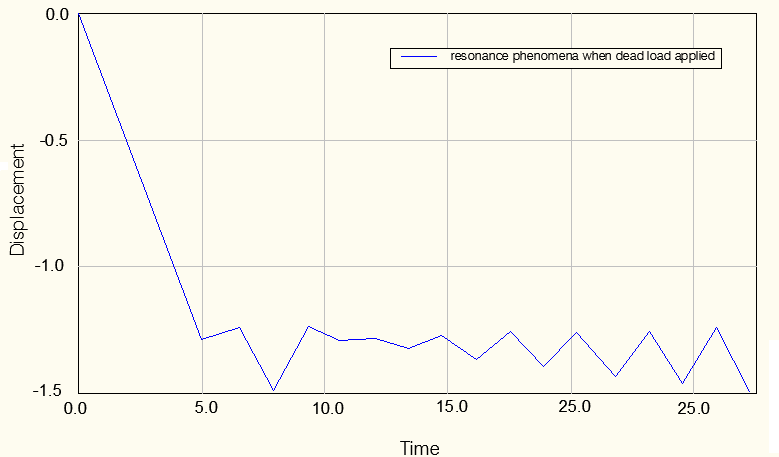 | Figure 22. Resonance phenomena when applying dead load of the structure |
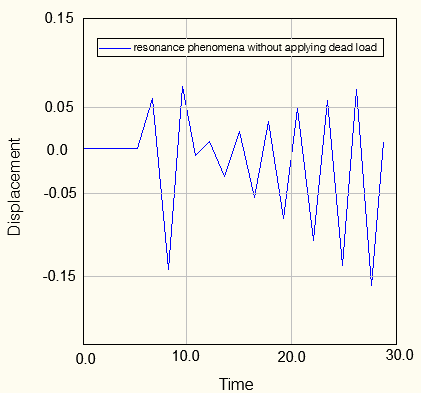 | Figure 23. Occurring resonance phenomena without applying dead load of the structure |
6. Conclusions
Since studying the dynamic behaviour of composite floors has special importance, so more than 75 structure samples with composite floors of the concrete slab and steel beam are studied in this paper.One of the main reasons for wide using of composite floors is the possibility of using these floors in places with wide area such as stores or places of accumulation that mostly has less columns in an architectural point of view and this leads to the thinness of structures and decrease its hardness, so in designing composite floors, it is necessary to observe the parameters and criteria of both sides.In this subject, the loading resulted from holding religious ceremonies in composite structures is studied. This type of loading maybe occurs in many places like fairs, stores, bridges and libraries that seem the effects of this load and its dynamic response is not mostly being considered. According to the study of different models, which modal analyses and loading were done on some of the samples and dynamically were analysed. the results are all obtained as following:In controlling resonance phenomena, we should not rely on several primary modes and study the next mode shapes. In this research, it was seen that in some of the samples, the natural frequency of structure in shapes 5 to 10 becomes resonated and this endangers the stability of the structure.In some of the samples, the natural frequency of the structure is close to the stimulus frequency of the structure, so it is necessary to create a security region for resonance by increasing the structural stiffness in these kinds of structures. Having had the structure’s frequency and displacement, we can get the feeling threshold of vibration by users.By paying attention to the models which were affected by the load resulted from people’s movements, it is clear that the maximum displacement occurs in the middle of the panels and the maximum tension of the concrete slab occurs around the central column of the structure, so in these samples, it is required to control the slab around the central column for occurring of punching phenomena.Point load has more effects on displacement and tension of composite slabs comparing with the same quantity of equivalent load.
References
| [1] | Lenzen, K. H. (1966). "Vibration of Steel joist-concrete slab Floors." Engineering Journal, AISC, Vol. 3, No. 3, PP.133-136. |
| [2] | Reiher HE, Meister FJ. The effect of vibration on people. Traduzido da Forsch Geb., Ohio. 1946. p. 381–6. |
| [3] | Hicks, S. (2004). "Vibration characteristics of steel-concrete composite floor systems." Progress in Structural Engineering Materials, Vol. 6, PP.21-38. |
| [4] | Murray, T. M. (1975). "Design to prevent floor vibration." Engineering Journal, AISC, Vol. 12, No. 3, PP.82-87. |
| [5] | Weber, W. and E. Weber, Mechanik der menschlichen Gehwerkzeuge. 1836, Göttingen: Dieterich. |
| [6] | Elftman, H. (1938). The measurement of the external forces in walking. Science 88, 152. |
| [7] | Rainer JH, Pernica G, and Allen DE 1987. Dynamic loading and response of footbridges. Structures Section, Institute for Research in Construction, National Research Council of Canada, Ottawa, Ont. Canada KIA OR6. p. 66–71. |
| [8] | Ebrahimpur A, Haman A, Sack RL, Patten WN 1996. Measuring and modeling dynamic loads imposed by moving crowds. Journal of Structural Engineering; 122(12):1468–73. |
| [9] | Murray TM, Hendrick WE 1977. Floor vibrations and cantilevered construction. Engineering Journal, AISC. |
| [10] | Alves NKC. Cargas Dinˆamicas devido a Pessoas em Movimento, Dissertac¸ ˜ao de Mestrado — COPPE/UFRJ. Rio de Janeiro, RJ, Brasil. 1997 [in Portuguese]. |
| [11] | Faisca RG. Caracterizac¸ ˜ao de Cargas Dinˆamicas Geradas por Atividades humanas, Ph.D. Tese, COPPE/UFRJ. Rio de Janeiro, RJ, Brasil. 2003 [in Portuguese]. |
| [12] | A.V.A. Mello, J.G.S. da Silva,_, P.C.G. da S. Vellasco, S.A.L. de Andrade, L.R.O. de Lima "Dynamic analysis of composite systems made of concrete slabs and steel beams" Journal of Constructional Steel Research 64 (2008) 1142–1151. |
| [13] | Australian Standard. (1993). Domestic Metal Framing Code, AS3623, Standards Association of Australia, Homebush, NSW. |





 where, Fy, Fu, E, v, F’c is yield strength, ultimate tensile strength, modulus of elasticity, Poisson's ratio and strength of concrete, respectively.The most important aim in this part of the research is composite slabs, finding the natural frequency of structure in different models. Steel columns and beams were modeled as shell in software and concrete slab as a shell. Frequency analyses were done on different structural samples and it was observed that in all samples, increasing the structural stiffness will increase the natural frequency of the structure. The frequency of a sample of composite floor with 9 columns was analysed and several of their samples are provided at the following, Figures (5, 6, 7, 8).
where, Fy, Fu, E, v, F’c is yield strength, ultimate tensile strength, modulus of elasticity, Poisson's ratio and strength of concrete, respectively.The most important aim in this part of the research is composite slabs, finding the natural frequency of structure in different models. Steel columns and beams were modeled as shell in software and concrete slab as a shell. Frequency analyses were done on different structural samples and it was observed that in all samples, increasing the structural stiffness will increase the natural frequency of the structure. The frequency of a sample of composite floor with 9 columns was analysed and several of their samples are provided at the following, Figures (5, 6, 7, 8).


















 Abstract
Abstract Reference
Reference Full-Text PDF
Full-Text PDF Full-text HTML
Full-text HTML